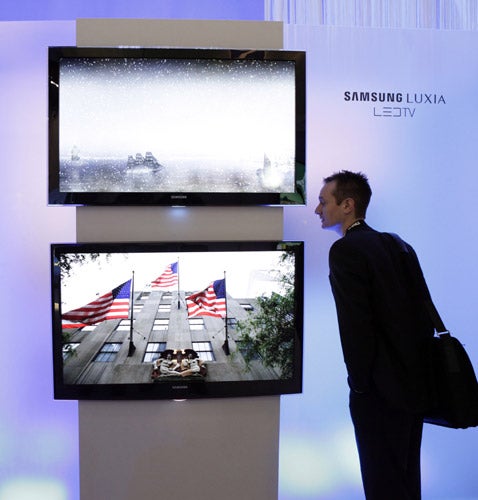Martin Hickman: The electrical revolution is bargain bliss
Consuming Issues

While pointing the finger at bankers for fleecing the public in crooked overdraft charges and payment protection insurance, the energy companies for making hundreds of millions off the back of artificially high prices, and food manufacturers for stuffing products with modified maize starch, fructose syrup and other garbage, one could be forgiven for thinking there are no bargains in 21st-century Britain. Thankfully there are, and they can be found in every electronics shop.
To hold an iPhone in your hand, to watch a flatscreen television, or to open a laptop spreadsheet, is to take your place at the top of a chain of human ingenuity spanning the globe, hundreds of suppliers and thousands of workers. Over the past decade, some aspects of life have changed little (cars, pubs, restaurants, all basically the same), but the information revolution has thrust products of astonishing complexity and smallness into our pockets, offices and homes.
Televisions, mobile phones, music players and computers are all rapidly becoming faster, sleeker and, almost as dramatically, cheaper. According to Moore's Law (devised by Intel boss Gordon Moore in 1965), computers' processing power doubles every two years. A modern computer has 250 times the memory of a computer just 10 years ago.
The principle applies, more or less, to all consumer electronics. Compare what you could buy in Dixons a decade ago with what is available on the high street this weekend.
In 1998, for £39, music lovers could snap up a state-of-the-art Sony Walkman, which could play a 90-minute tape. A modern Hitachi GB MP4 player can hold 500 songs, 25 times as many, for £29.
A decade ago, Dixons was selling a 32-inch Toshiba widescreen television for £1,599; this weekend, Currys has a 32-inch Samsung LCD for £349 – a quarter of the price.
Each gadget consists of hundreds of components made by specialist manufacturers, often thousands of miles from the gadget brand or its assembly. Because of commercial confidentiality, the supply chain is opaque. Apple, for instance, won't divulge any information about the innards of an iPod, but one study two years ago found it had 451 components. Academics at the University of California discovered a fifth-generation video iPod contained microchips, circuit boards and other items produced by an array of firms in the US and Asia-Pacific.
Toshiba made the most expensive item – the $73 hard drive – in Japan. Two US companies, Broadcom and PortalPlayer, made the processors. Samsung, Elpida and Spansion made the memory in the US, Japan and Korea. Chinese workers assembled the iPod. When the first model was launched, in 2001, a 5GB iPod cost a hefty £349. Today, John Lewis sells the 120GB iPod classic – with more than 20 times the storage – for half the price.
Gadgets are made not just by the vision of designers such as Apple's Jonathan Ive, or the skill of suppliers, but by the nimble hands of an army of unseen workers. Data on conditions in the hi-tech factories of China is scant, compared with the slew of reports from the likes of War on Want on clothes sweatshops.
Likewise, the extraction of raw materials generates few headlines (though Consumers International last year claimed the mobile-phone component coltan was fuelling conflict in the Democratic Republic of Congo; a similar report found children hacking out cobalt for rechargeable batteries). Although devices are becoming more energy-efficient, our love of them also raises greenhouse gas emissions.
Still, for shoppers, it's hard to come to any conclusion other than consumer electronics represent a bargain. By the time a gadget reaches you, the supply chain involves some of the cleverest people in the world, co-operation between dozens of electronics suppliers, the productive powerhouse of China's dirt-cheap labour and a journey of tens of thousands of miles, all zooming into your local shop. How much longer will this go on for? Moore's Law is forecast to end by 2015. And you'd be right that a better gadget will be along in a year's time. But still...
Heroes & Villains
Villain: Clarks
Great for measuring kids' feet; shame about the rainforest. According to a new Greenpeace report, 'Slaughtering the Amazon', Clarks is a major customer of Bertin, which indirectly buys leather from cattle ranches in the Amazon. Clarks says it is phasing out leather from Bertin in the UK.
Hero: KFC
KFC is to serve some un-fried chicken. In a nod towards healthy eating, a three-month trial is to begin in the North-east, where customers will be able to buy a griddled chicken ciabatta, with 345 calories, as well as other less fatty food. "We are trialling the griddled menu in response to the growing customer desire for new taste experiences, and lighter menu options," said MD Martin Shuker. A step in the right direction on a very long road...
m.hickman@independent.co.uk
Subscribe to Independent Premium to bookmark this article
Want to bookmark your favourite articles and stories to read or reference later? Start your Independent Premium subscription today.

Join our commenting forum
Join thought-provoking conversations, follow other Independent readers and see their replies